
1. John Noble was born 11 February 1771 in Ninety-Six District (later Abbeville County), South Carolina. This is the date of birth inscribed on John’s tombstone in the Unitarian Church cemetery in Charleston, Charleston County, South Carolina. The final digit of his birth year on his tombstone is now eroded. It’s fairly simple to make out that the tombstone states that John was born 11 February 177-, but that final – is not easy to read. When Caroline Howard Gilman transcribed the tombstone in 1860 before the birthdate became partly illegible, she read the birthdate to be 11 February 1771.[1]
John’s obituary in Charleston’s City Gazette on 24 February 1819 states that he was aged about 47 when he died on 4th or 5th February 1819.[2] The tombstone of John’s brother Ezekiel Noble in the Noble family cemetery at Willington, McCormick County, South Carolina, which is very legible, states that Ezekiel was born 28 March 1774.[3] Ezekiel was the next child in the family of Alexander Noble and Catherine Calhoun to be born following John, their first child.
John Noble matriculated at Princeton (College of New Jersey) in November 1789 at age 18 and graduated from Princeton in 1791.[4] On the multiple connections of members of the Calhoun kinship network to Princeton, a school founded by New Light Presbyterians to train Presbyterian ministers which was “the educational and religious capital of Scottish-Irish America,” see this previous posting.[5]
Following his Princeton education, John Noble studied medicine in Philadelphia and then France and on his return to the U.S., he opened a medical office and apothecary on King Street in Charleston. City directories in the early 1800s show him variously at 173, 175, 176, and 189 King Street. His brother Ezekiel had a mercantile business in these years at 153 King Street, and as we’ve seen previously, John and Ezekiel’s uncle John Ewing Colhoun had a house and law offices at 127 King Street, the property having been willed to John E. Colhoun and wife Floride Bonneau by her father Samuel Bonneau when he died in 1788. As the posting I’ve just linked and another previous posting state, a 16 April 1798 letter of John E. Colhoun to William Bonneau ends with a statement that Bonneau could write to John E. Colhoun at his Keowee Heights plantation in Pendleton District, enclosing letters to Ezekiel Noble, King Street, Charleston.[6] A previous letter written on 12 August 1793 by John Green to John E. Colhoun, uncle of John Green’s wife Jane Kerr (her parents were Mary Calhoun and Samuel Kerr), states that John Green had had a letter to him written by John E. Colhoun, which came to John Green via Ezekiel Noble.[7]
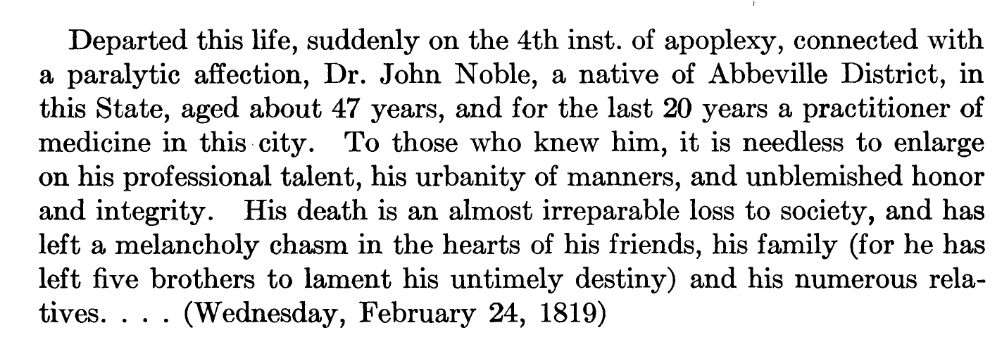
As stated above, on 24 February 1819 Charleston’s City Gazette published an obituary of Dr. John Noble stating that he had died suddenly of apoplexy in Charleston, aged about 47, a practitioner of medicine in Charleston for the last twenty years.[8] The obituary gives a death date of 4 February 1819, while John’s tombstone states that he died on 5 February 1819.[9] The obituary states,
To those who knew him, it is needless to enlarge on his professional talent, his urbanity of manners, and unblemished honor and integrity. His death is an almost irreparable loss to society, and has left a melancholy chasm in the hearts of his friends, his family (for he has left five brothers to lament his untimely destiny) and his numerous relatives.
On 12 March 1819, John Noble’s cousin John C. Calhoun wrote to John Noble’s brother Patrick about John Noble’s death, stating,
It was with deep sorrow I heard of the death of your brother. Few men had a warmer heart; or have passed through life with a more unblemished character. It has been his good fortune to have, I suppose, not an enemy behind him.
This letter is transcribed in Alice Noble Waring, “Letters of John C. Calhoun to Patrick Noble, 1812-1837,” Journal of Southern History 16,1 (February 1950), p. 69.
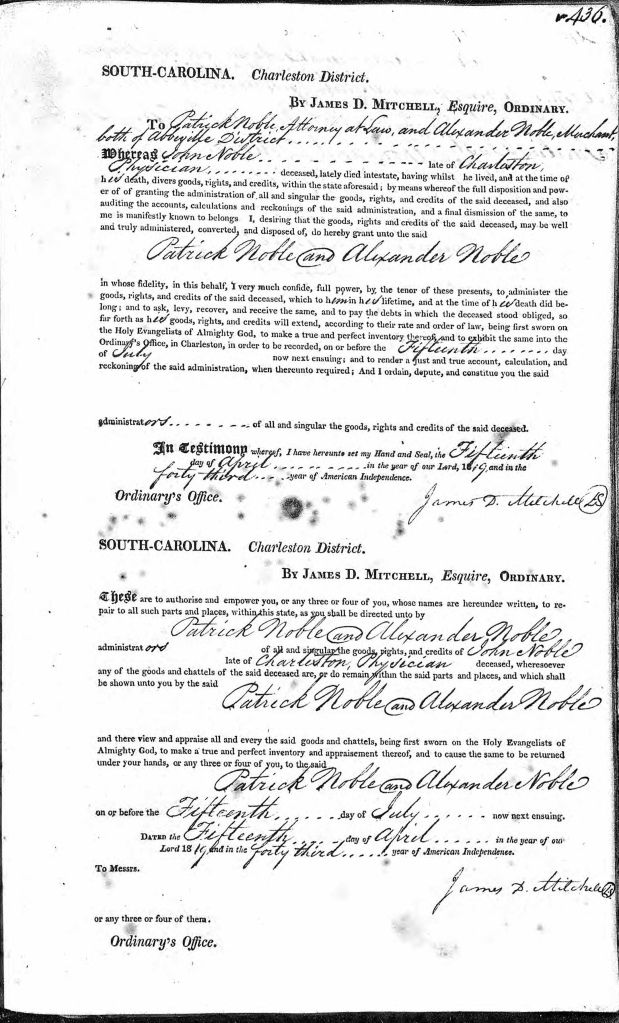
On 15 April 1819, John’s brothers Patrick and Alexander Noble received letters of administration on his estate in Charleston.[10] Litigation ensued after John’s death about the partition of his estate, with his brothers Ezekiel, William, and Joseph Noble filing suit on 15 February 1820 in Abbeville County’s equity court against their brothers Alexander and Patrick as administrators of John Noble.[11] Ezekiel, William, and Joseph filed suit to request a partition of 1,200 acres of land and enslaved people living on this land which had belonged to John, and was on the Savannah River adjoining the town of Vienna. The plantation was named Fort Charlotte. In addition to the five brothers named in the lawsuit, the equity court bill of complaint states that John left a niece Jane Catherine Casey, the only heir of their sister Jane Noble Casey.
In the traditional pattern of many families in the American South, John Noble was given the name of his paternal grandfather John Noble, as the oldest son of Alexander Noble and Catherine Calhoun.

2. Ezekiel Noble was born 28 March 1774 in Ninety-Six District (later Abbeville County), South Carolina. This date of birth is inscribed on his tombstone in Noble cemetery at Willington, McCormick County, South Carolina.[12] The tombstone inscription states that Ezekiel’s widow Mary Markley Noble, requested that the tombstone be erected in Ezekiel’s memory:
Ezekiel Noble
Born 28th March 1774.
Died 19th May 1832.
This monument
Is erected
By the dying request
Of his Widow
Mary E. Noble
In memory of his virtues
And sterling worth
And of her devoted affection

On 2 September 1798 in St. Philip’s parish, Charleston, Ezekiel Noble married Mary Elizabeth Markley, daughter of Abraham Markley and Mary Magdalen Gasser.[13] Mary Elizabeth is buried in Saint John’s Lutheran Church cemetery in Charleston with a tombstone stating that she was born 17 July 1778 and died 11 October 1844.[14]

As noted above, Ezekiel Noble had a mercantile business at 153 King Street in Charleston near the medical office and residence of his brother John and the residence and law office of their uncle John Ewing Colhoun in the early 1800s, though he resided in Abbeville County. Also noted above are a 12 August 1793 letter written by John Green, who married John E. Colhoun’s niece Jane Kerr, to John E. Colhoun, in which John Green states that a letter sent to him by John E. Colhoun had reached him via Ezekiel Noble, and a 16 April 1798 letter of John E. Colhoun to William Bonneau which states that Bonneau could write to him at his Keowee Heights plantation in Pendleton District by enclosing letters to Ezekiel Noble, King Street, Charleston. As a previous posting notes, Ezekiel Noble and his brother Alexander were witnesses to the will of John E. Colhoun on 20 May 1802.[15]
As a previous posting notes, Ezekiel ran family plantations with his brothers William and Alexander Noble, and engaged in cotton trade along with these brothers.[16] The online guide to the “Noble Family Papers,” a collection of family papers held in the manuscript collection of Huntington Library, San Marino, California, states,
Ezekiel Noble (d. 1732), William (1777-1823), and Alexander (1794-1821) ran family plantations, including Vienna Plantation on the Savannah River and were engaged in cotton trade.
Ezekiel’s home plantation and residence was Cherry Hill, near Moses Waddel’s Willington academy at Willington, McCormick County, South Carolina.[17] The plantation, whose house burned in years past, was close to the site of the Noble family cemetery in which Ezekiel and his brothers William and Patrick and other family members are buried. As has been noted previously, Moses Waddel, whose first wife was Catherine, daughter of Patrick Calhoun and Martha Caldwell, was paid by the estate of Ezekiel’s father Alexander Noble to tutor his brothers Patrick and Joseph following Alexander Noble’s death: on this, see this previous posting.
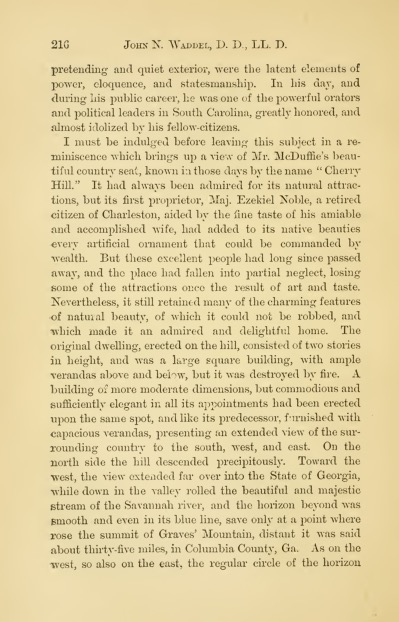
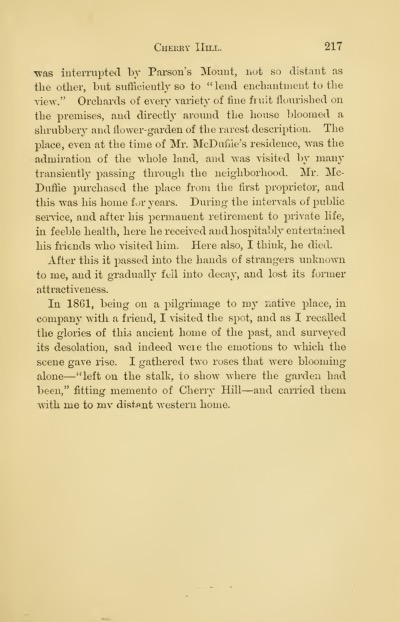
In a memoir he published in 1891, Moses Waddel’s son John Newton Waddel (1812-1895), who was chancellor of the University of Mississippi from 1865 to 1874, described Cherry Hill after it passed into the hands of George McDuffie, to whom Ezekiel Noble sold it.[18] Waddel describes Ezekiel as “a retired citizen of Charleston,” who, along with his wife, displayed excellent taste in how he furnished Cherry Hill and cultivated its surroundings – but by 1861, Waddel states, the place had fallen into severe disrepair.
A letter Ezekiel sent to his cousin John C. Calhoun on 30 May 1820 asking if Calhoun would recommend Ezekiel’s nephew William M. Lee to West Point indicates that Ezekiel may have called Cherry Hill “Cherry Mount” during his period of ownership of the plantation.[19] The letter is addressed to John C. Calhoun from Cherry Mount, South Carolina.
It appears that not long after Ezekiel sent this letter, he sold Cherry Mount to George McDuffie. As Walter B. Edgar notes, the panic of 1819 resulted in widespread losses for cotton planters in South Carolina and Georgia, including Ezekiel Noble.[20] Edgar writes,
Ezekiel Noble of the Abbeville District was forced to sell much of what he owned, including his household furnishings, to settle his debts. All he was left with was “a fine house… and nothing in it.”
A previous posting discusses a letter that John E. Colhoun’s son John E. Colhoun Jr. sent to his brother James Edward Calhoun on 10 September 1824, John writing from Pendleton District to James Edward at the Naval Office in New York.[21] In the letter, John tells his brother James that he had received a letter from Ezekiel Noble telling John that he would meet John at the home of the widow of their uncle Andrew Norris to hand John the papers for James’ Midway plantation in Abbeville County. Andrew Norris had been managing the plantation for James while James was in the Navy, and had died 31 July 1824.
As with his brother John, as the second-born son of Alexander Noble and Catherine Calhoun, Ezekiel Noble was named for a grandfather, in this case, for Catherine’s father Ezekiel Calhoun.

3. William Noble was born in 1777 in Ninety-Six District (later Abbeville County), South Carolina. A number of published sources give him a birthdate of 6 January 1777, but without citing a source for this birthdate. This child of Alexander Noble and Catherine Calhoun was discussed in a previous posting that focused on the children of Andrew Pickens and Rebecca Calhoun: as that posting indicates, William married his cousin Rebecca Pickens, whose parents were Andrew and Rebecca Calhoun Pickens. The posting provides biographical information about William, with a digital image of his tombstone in the Noble family cemetery at Willington, McCormick County, South Carolina,[22] and images of documents in his loose-papers estate file in Abbeville County.[23] As the tombstone shows, William died in Abbeville County on 7 October 1823, with his tombstone inscription stating that he was in his 47th year at the time he died.
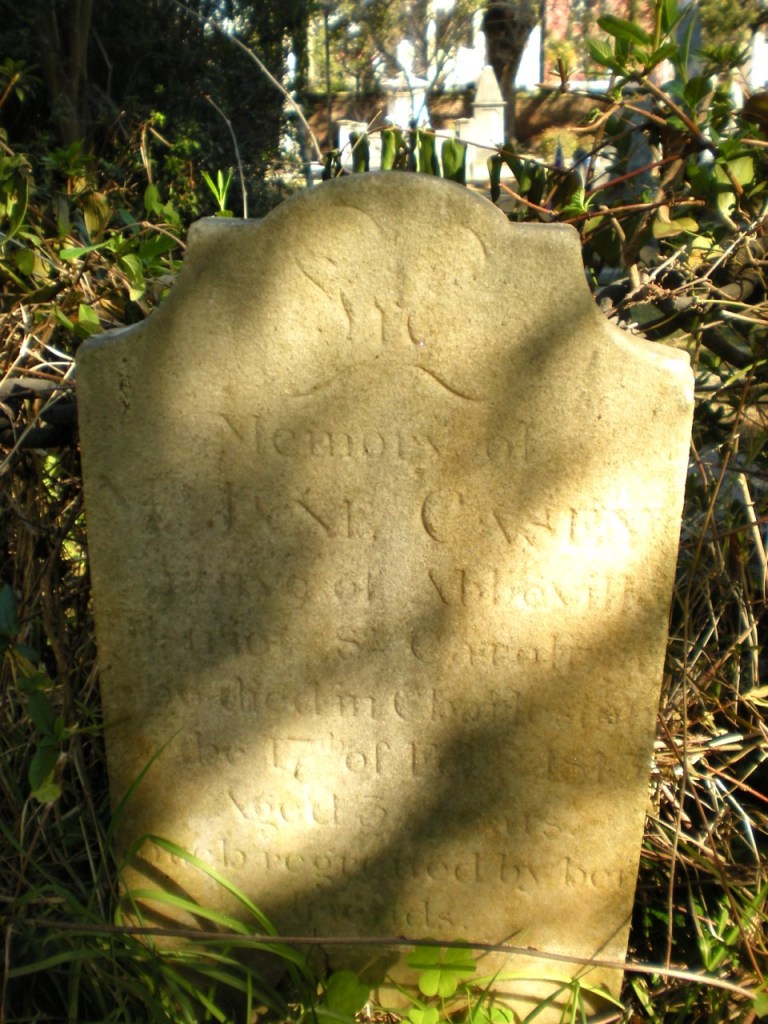
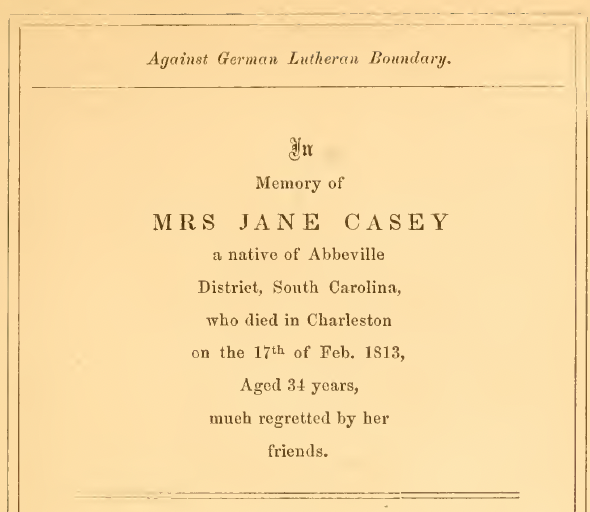
4. Jane Noble was born in 1779. Her tombstone in the Unitarian Church cemetery in Charleston states that she was aged 34 when she died 17 February 1813.[24] The tombstone gives Jane’s name as plain Jane Casey, though the Find a Grave memorial page for her and many published family trees call her Jane Catherine, which was the name of her daughter. I have seen no documents anywhere calling Jane anything other than Jane Noble or Jane Casey. As the first-born daughter of Alexander Noble and Catherine Calhoun, Jane was named for her maternal grandmother Jane/Jean Ewing Calhoun.
In a letter she sent to William Berrien Burroughs of Rome, Georgia, on 9 May 1895, Mary Berrien Whitmore wrote,[25]
My father’s first wife was Catherine Jane Casey, a South Carolinian by birth, but at the time of their marriage, living in Mobile, Alabama, with her father. Her mother was Jane Noble, a sister of Governor Patrick Noble of South Carolina.
Mary Berrien Whitmore’s father was James Weemys Moore Berrien.
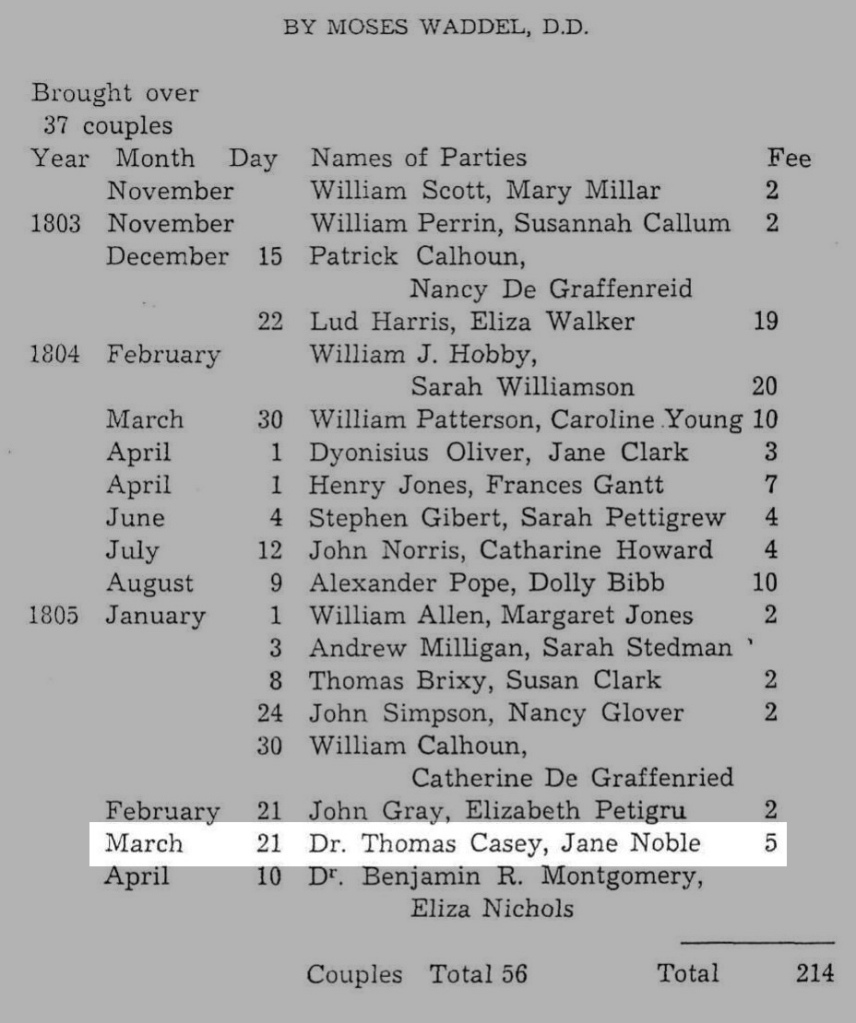
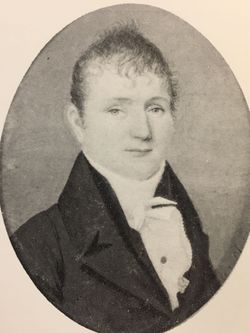
On 21 March 1805 in Abbeville County, Jane Noble and Dr. Thomas Casey were married by the celebrated South Carolina divine Reverend Moses Waddel, whose first wife was Catherine Calhoun, daughter of Patrick Calhoun, an uncle of both Jane’s mother and father, and wife Martha Caldwell. Moses Waddel recorded the marriage in a register of marriages he kept in the period 1795-1836, the original of which is in the Library of Congress.[26] As was noted above, Moses Waddel was paid by the estate of Jane’s father Alexander Noble to tutor her brothers Patrick and Joseph: see this previous posting for information about him.
As noted previously, Jane Noble Casey died 17 February 1813 in Charleston and is buried in the Unitarian Church cemetery there, in which her brother John Noble is also buried.[27]
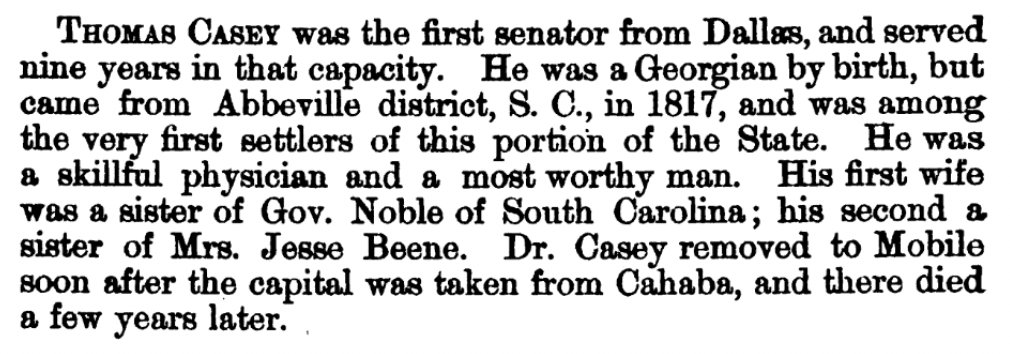
Thomas Casey moved to Alabama following the death of his wife Jane, and as his biography in W. Brewer’s Alabama: Her History, Resources, War Record, and Public Men states, he was the first senator to represent Dallas County, Alabama, in the Alabama Senate, and was a doctor.[28] As a previous posting notes, a migration of members of the Pickens and Calhoun families from Pendleton District, South Carolina, to Dallas County, Alabama, took place in or just after 1819, with Joseph Pickens’ brother Andrew, his sisters Jane, Margaret, and Catherine, and their nephew Ezekiel Pickens all taking part in this migration.
After first having lived in Dallas County, Thomas Casey settled in Mobile, where he remarried to Eliza Bird, daughter of William Bird and Catherine Dalton, who was a widow Lesley when Thomas Casey married her. Thomas Casey died in Mobile on 21 October 1834 and is buried in Magnolia cemetery along with wife Eliza.[29]
In a subsequent posting, I’ll provide information about the last three children of Alexander Noble and Catherine Calhoun, their sons Patrick, Joseph, and Alexander.
[1] See Find a Grave memorial page of Dr. John Noble, Unitarian Church cemetery, Charleston, Charleston County, South Carolina, created by Judy Llamas, with tombstone photos by Judy Llamas and camposanto; and Caroline Howard Gilman, Record of Inscriptions in the Cemetery and Building of the Unitarian, Formerly Denominated the Independent Church, Archdale Street, Charleston, S.C., from 1777-1860 (Charleston: Walker, Evans & Co., 1860), p. 29.
[2] The obituary is transcribed in Elizabeth H. Jervey, “Marriage and Death Notices from the City Gazette of Charleston, S. C. (Continued),” South Carolina Historical and Genealogical Magazine 45, 4 (October 1944), p. 196.
[3] See Find a Grave memorial page of Ezekiel Noble, Noble cemetery, Willington, McCormick County, South Carolina, created by Gypsy Soul, with tombstone photos by James Bates and Gypsy Soul.
[4] J. Jefferson Looney and Ruth L. Woodward, Princetonians, 1791-1794: A Biographical Dictionary (Princeton: Princeton University Press, 1991), pp. 84-5.
[5] The statement that Princeton was “the educational and religious capital of Scottish-Irish America” is in “History of Princeton University” at Wikipedia.
[6] The letter is in the John Ewing Colhoun Papers held by Wilson Library at University of North Carolina, Chapel Hill.
[7] The letter is in the John C. Calhoun family papers, 1765-1818, special collections, at the Rubenstein Library, Duke University. A digital image of the letter is at this previous posting.
[8] See supra, n. 2.
[9] See supra, n. 1.
[10] Charleston County, South Carolina, Letters of Administration 1815-9, p. 436.
[11] Abbeville County, South Carolina, Equity Court files, box 6, pkg. 178.
[12] See Find a Grave memorial page of Ezekiel Noble, Noble cemetery, Willington, McCormick County, South Carolina, created by Gypsy Soul, with tombstone photos by Gypsy Soul and James Bates.
[13] Register of St. Philip’s Parish, Charles Town, or Charleston, S.C., 1754-1810, ed. D.E. Huger Smith and A.S. Salley Jr. (Columbia: University of South Carolina Press, 1971), p. 262.
[14] See Find a Grave memorial page of Mary Elizabeth Markley Noble, Saint John’s Lutheran Church cemetery, Charleston, Charleston County, South Carolina, created by Saratoga, with tombstone photos by Saratoga and bien recordado.
[15] Anderson County, South Carolina, Will Bk. 1791-1834, pp. 22-31; Charleston County, South Carolina Will Bk. D, 1800-7, p. 361-4. See also Virginia Alexander, Coleen Morse Elliott, and Betty Willie, Pendleton District and Anderson County, South Carolina, Wills, Estates, Inventories, Tax Returns, and Census Records (Easley, South Carolina: Southern Historical Press, 1980), p. 29.
[16] See “Noble Family Papers,” an online guide to a collection of family papers found in the manuscript collections of Huntington Library, San Marino, California.
[17] “Cherry Hill / Noble Cemetery,” Historical Marker Database
[18] John Newton Waddel, Memorials of Academic Life, Being an Historical Sketch of the Waddel Family, Identified Through Three Generations with the History of the Higher Education in the South and Southwest (Richmond: Presbyterian Committee of Publication, 1891), pp. 216-7. See also Bobby F. Edmonds, The Making of McCormick County (McCormick: Cedar Hill, 1999), pp. 185-6.
[19] The Papers of John C. Calhoun, vol. 5: 1820-1, ed. W. Edwin Hemphill (Columbia: University of South Carolina Press, 1971), p. 152.
[20] Walter B. Edgar, South Carolina: A History (Columbia: University of South Carolina, 1998), p. 274.
[21] The letter is in the “John Ewing Colhoun Papers, 1774-1961,” collection 130, Wilson Library, University of North Carolina at Chapel Hill, available digitally at the library’s website
[22] See Find a Grave memorial page of William Alexander Noble, Noble cemetery, Willington, McCormick County, South Carolina, created by Gypsy Soul, with a tombstone photo by Gypsy Soul. I have seen no documents anywhere giving William Noble the middle name Alexander. Every document I’ve seen gives his name as simply William Noble.
[23] Abbeville County, South Carolina, Probate Files, box 71, pack 1738.
[24] See Find a Grave memorial page of Jane Catherine Noble Casey, Unitarian Church cemetery, Charleston, Charleston County, South Carolina, created by Judy Llamas, with a tombstone photo by Saratoga; and Gilman, Record of Inscriptions in the Cemetery and Building of the Unitarian, Formerly Denominated the Independent Church, Archdale Street, Charleston, S.C., from 1777-1860, p. 29.
[25] The letter is transcribed at the Glynn County, Georgia, website GlynnGen in a section of this site transcribing material from a typescript book entitled The Burroughs Book written by Mac Hazlehurst Burroughs in 1947. On The Burroughs Book, see this page on the GlynnGen site. The letter is on p. 465 of The Burroughs Book. Wilson Library’s Special Collections department at University of North Carolina, Chapel Hill, has a collection of Mac Hazlehurst Burroughs’ papers entitled “Mac Hazelhurst Burroughs Papers, 1741-1949,” collection 1923.
Burroughs Family, p. 495: Letters & Correspondence from “The Burroughs Family”
[26] A Register of marriages celebrated & solemnized by Moses Waddel, D.D., in South Carolina and Georgia, 1795-1836 ([South Carolina?]: Historical Markers Service of South Carolina, 1943) p. 3, available digitally at FamilySearch in a typescript transcription.
[27] See supra, n. 12.
[28] W. Brewer, Alabama: Her History, Resources, War Record, and Public Men from 1540 to 1872 (Montgomery: Barrett & Brown, 1872), p. 216.
[29] See Find a Grave memorial page of Thomas Casey, Magnolia cemetery, Mobile, Mobile County, Alabama, created by Tim Childree, maintained by Eireannach, with a tombstone photo by Tim Childree.
One thought on “Children of Alexander Noble and Catherine Calhoun (1): John, Ezekiel, William, and Jane”